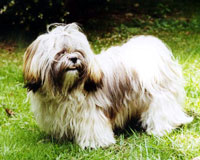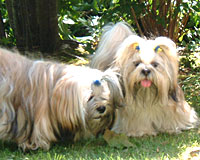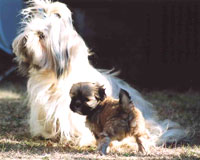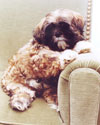In 1928 Colonel Bailey, a British aristocrat and mountaineer, brought a Lhasa Apso from Tibet to England. In 1929 Lhasa Apso was first introduced at an England dog show and gained popularity as an oriental talisman dog. In 1933 it was recognized as an official breed by the UK Kennel Club. The name of the breed was Lhasa Terrier at that time. In 1939 Chinese military invaded Tibet. As Chinese incursion threw Tibet into chaos, about 100,000 Tibetan refugees escaped to India and Bhutan by crossing borders risking their lives. Lhasa Apsos treated like family members were also taken along on the back of yaks or in the arms of refugees, over 6,000 meters high Himalaya Mountains. In 1959 the 14th Dalai Lama escaped from Tibet. It was reported all over the world that the Dalai Lama with a Lhasa Apso in his arm on the way from Tezpur to Mussoorie. In the biography of the 14th Dalai Lama, the Lhasa Apso named Tashi, a gift from the Sherpa, Tinzin Nolgei, famous for summiting Everest, is well explained. The tale of Lhasa Apso being privileged class pet was born at this time; however, in reality of Tibet, Lhasa Apso has been loved by every hierarchy, from beggar to nomad, from high priest to aristocracy. |
|
During the same year Lhasa Apso was first registered at Japan Kennel Club. There were 32 dogs. 100 Lhasa Apsos, finally a 3-digit figure, were registered in 1979. The number boosted to 300 in the early 1990s during a bubble period, and then shifted to about 100 today. The unpopularity leaves no chance to enter dog shows in Japan. It is also said that being unconnected with dog shows has no economic advantages for breeders and owners. Westernized Lhasa Apso, given bizarre and often considered abnormal and caricatured features for dog shows, now viewed as problematic, didn't come to Japan. There are disappearing original Apsos, which are small dogs with a black face and almond-shaped eyes, left in Japan. [Refer to the pictures in our club.] |
|
★The detail explanation of differences between the original and the recent breed will be found at the web site, supporting Tibetan Lhasa Apso. Lhassa Apso Tibetain http://www.tibetan-lhasa-apso.com/Us/UsFrm.html Please refer to the websites, such as UK's or the other countries, for Lhasa Apso characteristics, etc. |
|
From very early times, this small lion-dog was given to China's emperors by the Dalai Lama: the dog was officially called Apso Seng Kyi. Apso--- hairy in Tibetan. Seng--- means lion. Kyi--- means dog. Many dog historians indicate that Apso Seng Kyi is the ancestor of Pekingese, Shih Tzu and Japanese Chin. |




